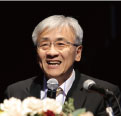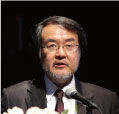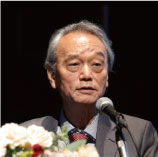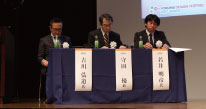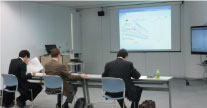| Day3 11/17 Fri. | The 10th Design Conference IM&VR i-Construction Session |
||
New and Existing Concrete Structures, Specifications for Highway Bridges, and Latest Trend of CIM
On the Design Festival Day3 (Nov. 17, 2017), IM&VR i-Construction Session of The 11th Design Conference was held from the morning part to the first half of the afternoon part. In the latter part of the afternoon part, the prize announcement and award ceremony were held for "The 4th National Resilience Design Award (NaRDA)".
Following the opening speech, Day3 started with a special lecture by Prof. Koichi Maekawa, Concrete Lab., Department of Civil Engineering, Graduate School of Engineering, the University of Tokyo, entitled "Data assimilation of performance verification of new structures and inspection data of existing structures". He mentioned the current status that applicable scope of nonlinear analysis in concrete structures is expanding. Then he showed his own viewpoint regarding shear transfer, then explained verification of the ultimate limit state of new structures, verification of the medium- and long-term serviceability limit state including combination of environmental actions and load, and evaluation of them, using specific examples. Moreover, as inspection data of existing structures increased rapidly, their effective use was required. On the contrary, there were some structural problems that made nonlinear analysis unable to treat them. He expressed his thoughts about this process of trial and error. Regarding this, he talked about his attempt of data simulation for uniting inspection information and numerical analysis (data assimilation), which he and others had been working on in "The Cross-ministerial Strategic Innovation Promotion Program (SIP)" (Cabinet Office, Government of Japan). He also explained possibility of its utilization in maintenance by mutual complement of advantages and disadvantages of each of inspection data and nonlinear analysis. In addition, he mentioned constrains that had emerged through the current SIP project. In working out countermeasures for them, an approach was devised, in which artificial intelligence (AI) is trained with the results of numerical analysis as training data. Based on their results, he introduced an attempt to obtain the inspection data of bridges automatically while driving on expressways and actually connect them to numerical analysis.
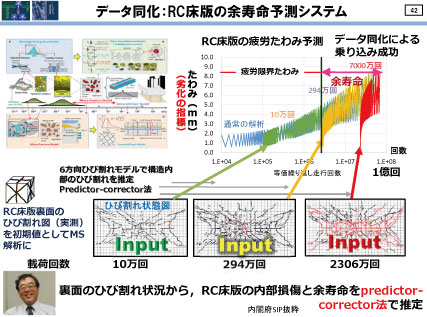 |
 |
||
|
Following this lecture, FORUM8 staff members made presentations entitled "The latest information of FEM series and future vision". In the first half, one of them explained the new functions of the latest version of Engineer's Studio(R) and support for the 2017 revision of Specifications for Highway Bridges. He also talked about the new functions of WCOMDStudio, the overview of Geo Engineer's Studio and the latest information about FEMLEEG while showing demonstration. In the latter half, from the developer's point of view, the other member talked about further points of Engineer’s Studio(R) to support 2017 revision of Specifications for Highway Bridges. Then he also explained the concept for the future expanding of the products that constitute FEM series, with their points and release schedule.
The morning part was closed by the presentation entitled "FORUM8's correspondence to the new Specifications for Highway Bridges" made by FORUM8 staff. First, he explained the main contents of the latest version of Specifications for Highway Bridges (2017 revision) and its points to keep in mind. Following this, he explained the points to support the revision and planned step-by-step revision in our products with Bridge superstructure and Bridge substructure series of UC-1 series as the main items, and comparison between the latest product that reflects the revision and the old version (supporting 2012 version of Specifications for Highway Bridges), while showing operation for case examples.
The afternoon session opened up with a special lecture, "CIM update information -VR/AR/IoT/Big Data-" by Prof. Nobuyoshi Yabuki, Division of Sustainable Energy and Environmental Engineering, Graduate School of Engineering, Osaka University. After mentioning various issues around the constructing industry, he summarized the topics such as BIM (Building Information Modeling), which the architectural community had been working on since 2004 as one of the solutions, and the flow to CIM (Construction Information Modeling) that had been promoted by Ministry of Land, Infrastructure and Transport (MLIT) for the civil engineering area since 2012 based on that idea, interspersing comparison between the trends of the world and Japan. Then he explained the definition of CIM in his understanding, actions of MLIT for introducing CIM so far, the overview and points of "Guidelines for introduction of CIM (draft)" formulated in March 2017 as part of this, trends of relative international standardization including buildingSMART International and response of Japan etc. Additionally, he developed his speech to the framework policies and aims of i-Construction, which MLIT had been promoting in parallel of this since 2015; foreign activities related to BIM/CIM centering on major nations of Europe, America, and Asia; new movement around the ordering method for the purpose of quality assurance and attention to ECI (Early Contractor Involvement); and actions towards training CIM engineers based on Program Manager in the U.S.A. for BIM. Furthermore, he introduced researches in his lab in relation to these trends in recent years as follows: 1) Visibility study of direction guidance boards in the station using VR and multi-agents, 2) Visualization of environment data such as temperature, humidity, and wind using AR, 3) Utilization of LPWA (Low Power Wide Area) as part of IoT, 4) Detection of concrete cracks using deep learning, 5) Position detection of pictures by image matching using 3D models created by SFM (Structure from Motion), and 6) Study on utilizing the sensing data accumulated through IoT by linking them with AR. He then showed expectation to use of AI in maintenance of infrastructure treated through SIP heading towards Society 5.0, innovative technologies for construction and maintenance of infrastructure in "Public/Private R&D Investment Strategic Expansion PrograM: PRISM" (Cabinet Office, Government of Japan), and new development in ICT use relating to innovative technologies for preventing and mitigating disasters.
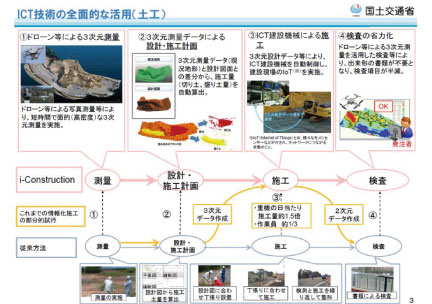 |
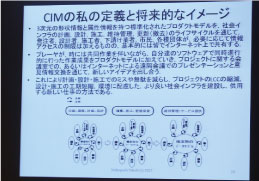 |
||
|
Next, FORUM8 staff made a presentation entitled "IM&VR CIM solutions and i-Construction". He explained the concept of IM&VR CIM solutions provided by FORUM8 to place UC-win/Road as the core and link the data of diverse software programs of design and analysis, history of utilizing 3D models and extending simulation functions over the last two decades, and main products that support CIM and development plans in the future. At the same time, he mentioned point cloud data modeling and its utilization as a measure to support i-Construction. He explained various ways of utilizing VR created with methods such as SFM, using the award-receiving works of the past 3D VR Simulation Contest on Cloud as examples. He also mentioned the major features of the latest version of UC-win/Road (ver.12) and new functions under development, linkage with many kinds of systems, and the future prospect in consideration of national policies such as Society 5.0.
The final presentation of the Design Conference was made by Mr. Tatsuoki Inagaki, Executive board member, State of the Art Technologies in Expression Association, entitled "Expression Technology Test (Architecture ICT)". After presenting the basic policies of the Association, he illustrated the background of the idea of Expression Technology Test as one of the approaches to them, and the idea to aim at contributing to diffusion of leading-edge and advanced Construction ICT that supports national policies (Society 5.0, CIM, i-Construction and so on) through the Test. He also mentioned the present situation in which they were starting study towards formal public release in the spring of 2018.
(Written by Takashi Ikeno)
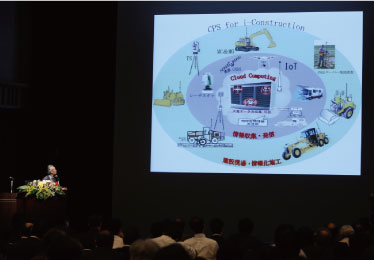 |
|

| Day3 | The 3rd National Resilience Design Award |  |
||
New challenge about energy
The prize announcement and award ceremony of "The 4th National Resilience Design Award (NaRDA)", which applaud cases and results contributing to national resilience had the honor of Day3 closing. Same as last year, the judging committee consisted of Prof. Hiromichi Yoshikawa (Earthquake Disaster Mitigation Engineering laboratory, Tokyo City University), Prof. Masaru Morita (Vice-president / Urban Environmental Engineering Laboratory, Civil Engineering Department, Shibaura Institute of Technology), and Prof. Akihiko Wakai (Science and Engineering Department, Gunma University). Prof. Yoshikawa played a roll of the chief of the judging committee.
On 11th November, the final judgment was conducted for submitted works in the fields of civil and architecture analysis, ground, water work, and disaster prevention. At the award ceremony, overviews of all nominated works from submitted works were introduced, and the Nomination Award was given to each applicant. From the nominated works, the Grand Prix "Design of solar cell support structure" (by Next Energy & Resources Co., Ltd.), Excellent Award as Semi Grand Prix "Examination of consistency by full scale experiment and nonlinear pushover analysis for PC-well" (by Nippon Concrete Industries Co., Ltd.), and each Judge's Special Prize were awarded.
In the jury's summary, the committee chief Prof. Yoshikawa commented that the Grand Prix work was a new initiative because it is related to energy. Moreover, he said that it is also important how easy and less number of pages they show own design according to the concept of NaRDA, which would be hundreds of pages if written in calculation sheets.
In the jury's summary, the committee chief Prof. Yoshikawa commented that the Grand Prix work was a new initiative because it is related to energy. Moreover, he said that it is also important to show their own works, which would be hundreds of pages if written in calculation sheets, in easily comprehensible way and in low number of pages according to the concept of NaRDA.
|
|

